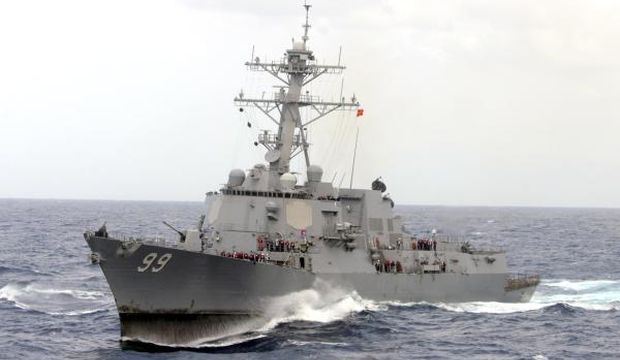
The guided-missile destroyer USS Farragut is shown in this undated photo operating in the Atlantic Ocean. (Reuters/Aaron Chase/US Navy/Handout)
Washington, DC and Riyadh, Asharq Al-Awsat—The Pentagon on Tuesday accused Iran of “provocative behavior” after the naval wing of Tehran’s Islamic Revolutionary Guard Corps seized a Marshall Islands-flagged cargo ship traveling through the Strait of Hormuz, the same day the Saudi-led coalition against the Houthis in Yemen prevented an Iranian plane from landing in Sana’a airport.
The MV Maersk Tigris was intercepted by at least five Revolutionary Guard patrol boats that forced the ship to divert toward the Iranian port of Bandar Abbas. The ship’s captain initially refused to follow the patrol boats further into Iranian waters but complied after the naval forces fired warning shots across the ship’s bow.
Pentagon spokesman Col. Steve Warren said the warning shots were “inappropriate” considering the ship was traveling through an internationally recognized maritime route. The Strait of Hormuz is one of the world’s busiest oil-shipping waterways.
After receiving a distress call from the Tigris, the US Navy sent the USS Farragut in pursuit of the commercial ship. The Marshall Islands is a former US colony and retains close defense ties with the US.
The MV Maersk Tigris is managed by the Rickmers Group but on hire to Danish shipping company Maersk. Rickmers spokesman Cor Radings told Reuters on Wednesday the ship’s 24-strong crew, mostly from Eastern Europe and Asia, were “in relatively good condition and safe.” He also echoed Warren’s comments regarding the legitimacy of the route the ship was taking.
“It is the Strait of Hormuz, which is literally in Iranian waters. But there is an internationally acknowledged shipping corridor in international waters which is used by commercial shipping,” he said.
Despite initial reports that the ship was seized for trespassing Iranian waters, Iran-based news agency Tasnim said the ship was diverted due to a lawsuit filed by Iranian company Pars Talaie against Maersk. It quoted a Pars Talaie lawyer who said the lawsuit was filed because the Danish company did not deliver a cargo scheduled to arrive in Dubai from the Iranian port of Abadan more than a decade ago.
The interception of the ship follows another similar incident that occurred on Friday. A senior US military official revealed on Tuesday that four Iranian boats had intercepted the US-flagged Maersk Kensington last week.
Both incidents come as the US and Iran look to improve decades-long tense relations, having just struck a framework deal to curb Tehran’s controversial nuclear program earlier this month.
The Gulf region has recently seen heightened tensions between Iran and Saudi Arabia after the Iran-backed Shi’ite Houthi movement in Yemen took over the capital Sana’a in September last year, eventually launching a coup in February and forcing the internationally recognized President Abd Rabbuh Mansur Hadi to flee the country.
Saudi Arabia and its Arab allies have accused Tehran of supporting the Houthi militia by providing the group with weapons, supplies and funds, as well as training Houthi militias in Iran.
On Tuesday, the Saudi-led coalition fighting the Houthis said it had prevented an Iranian commercial plane from landing in Sana’a airport.
Coalition spokesman Brig. Gen. Ahmed Asiri told Asharq Al-Awsat by telephone that the plane had been given permission to land but had missed a deadline specified to enter Yemeni airspace.
The plane’s pilot had not answered calls from air traffic control in Jeddah to land in Bisha Airport in southwestern Saudi Arabia, so that the plane could be searched, which Asiri said was a routine measure following the coalition’s enforcement of a blockade over Yemeni airspace. Asiri added that the Iranian plane had agreed to follow the measures prior to heading into Yemeni airspace.
After bypassing the agreed-upon route, the plane headed straight for Sana’a, which resulted in coalition warplanes scrambling to track the aircraft. When the pilots did not respond to additional calls from coalition’s warplanes to follow procedure, the coalition’s planes bombed Sana’a airport’s runway to prevent the Iranian plane from landing.
The pilot of the Iranian plane was then informed the runway had been targeted and promptly changed course, heading toward Omani airspace.
Asiri called the Iranian plane’s actions “unacceptable,” especially considering the incident would delay humanitarian aid to Yemen, most of which has arrived via planes landing at Sana’a airport.
Nasser Al-Haqbani contributed additional reporting from Riyadh.
